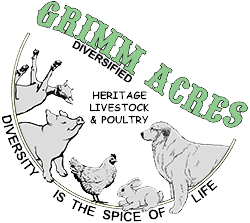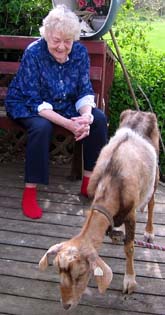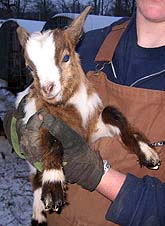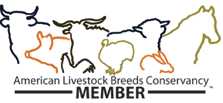Information on Goats
Tennessee Fainting Goats
All of our Tennessee Fainting Goats are registered with the Myotonic Goat Registry (MGR), and I send the transfer form along with information about the vaccination history, worming, and all parental health history with all the goats I sell. The MGR form has all of the information you need to register your goat. The parent goats are here on site, and potential buyers as well as interested visitors are welcome to come by and see the goats.
Does
The girls are sweeties, and we so enjoy their company. The kids (people type) that visit love to see them “faint”.
We ensure our does are current with CD&T and revaccinate as needed to ensure they will have had the vaccine within one month of the expected kidding date. We worm all of goats according to The FAMACHA method. You can read about the FAMACHA program is detailed on the website www.scsrpc.org.
In the winter or anytime the weather is at an extreme we move our expectant does near the house so that I can keep an eye on them. We have ‘hoop houses’ with plenty of clean straw and heat lamps for cold weather. During the summer, if the pasture is good and it is not rainy or “crazy hot” I leave the does to pick their own spot to kid. Fainting Goats rarely have problems kidding and are excellent mothers.
Births
These goats often have twins and even triplets on occasion! The does give birth with little or no difficulty. I have very rarely had to intervene in any kid birth, as the moms just seem to have it under control.
When kids are born here at Grimm Acres I dip the navel in betadine solution, or tincture of iodine, then clamp and trim the cord if it is more than 6 inches long. I do that because I’m concerned that if left longer the umbilical cord might be stepped on or pulled. Then I give the newborn ½ ml of Bova-Serum subcutaneously (under the skin of the shoulder area). They also receive their first dose of CD&T (Clostridium perfringens type C + D and tetanus).
We don’t separate the kids from the mom unless there is a severe problem. This winter we have brought several kids into the house overnight. Each was born late in the evening when the temperature was expected to dip below 10 degrees (F). In each case I made sure the little guy or girl had nursed successfully from Mom first. I then took the cuddly baby into the house and enjoyed holding her for several hours. At bedtime I put her to sleep in a warm basket, and returned her to Mom at first light. Each time the new mother sniffed the kid, gave me a reproachful look, and took it back without incident. A much better plan for the future includes a secure heated area where mother and kid can spend the first few nights when the weather is so severely threatening.
Scrapie
All goats are required to have scrapies tags when they leave our farm, and if they are crossing state lines they must have health papers (at the buyers expense). Our vet, Dr. Donald St Ledger will do the exam and put all of the goats you buy on one paper that keeps the expense down. I just need a few days to a weeks notice before you plan to pick your goats up. I will also need your name, farm name if applicable, physical address and contact number.
Feed
Since we only have a few goats, maintaining their body score at an optimal level year round is easier for us than for keepers of large herds. We interact twice daily with them and make on the spot adjustments as needed.
We feed all of the good quality hay the goats want and plenty of clean water. The goats get a daily feeding of a small amount of mixed grains, alfalfa pellets and commercial feed. When soaked in water it easy to add diatomaceous earth and the assorted herbs I like to feed the livestock. There is a reference with a nutritional chart on the North Dakota State University Agriculture Communication site: “Sugar Beet Byproducts Alternative Feed for Sheep” by Reid Redden and Alison Crane. I also add yogurt and yeast to the mix at times. We keep salt blocks and loose minerals or kelp in mineral feeders available to the goats “free choice”.
I am very interested in fermented feeds and sprouted grains but have only used them sporadically due to time/labor constraints. I make my own wormer “cookies” from rolled oats, molasses, Diatomaceous Earth, wormwood (non-pregnant does) and a variety of herbs and minerals (see: 6 Alternative worming strategies) . The goats get a “cookie” each week and any special need ingredients can easily be added to the individual goats treat. Once a month I add Selenium / Vitamin E gel to the “cookies”.
Vaccinations
The University of Maryland Extension site “Small Ruminant Info Sheet” by Susan Schoenian (http://www.sheepandgoat.com/articles/flockvaccinations.html) reads, “Probably, the only universally recommended vaccine for sheep and goats is CD-T. CD-T toxoid provides three-way protection against enterotoxemia (overeating disease) caused by Clostridium perfringins types C and D and tetanus (lockjaw) caused by Clostridium tetani. Seven and 8-way combination vaccines for additional clostridial diseases such as blackleg and malignant edema are available, but generally not necessary for small ruminants.”
I begin vaccinating with CD&T at birth. They receive additional doses at 4, 8 and 12 weeks, then again at 6 months or when the rest of the herd gets their annual booster, which ever come first. CD&T can be administered by your vet, or you can purchase the vaccine to administer to your goats yourself from many locations that carry livestock supplies. We are also currently also administering Pasteurella (Pneumonia) Vaccine.
Hoofs
We trim the goat’s hoofs ‘as needed’ or at least every 4 months. A copper based solution applied with a paint brush will help keep the hoofs from developing any infections especially when the ground is wet. We purchase most of our vet type supplies on-line from Hoegger Goat Supply (http://www.hoeggergoatsupply.com), but you can also get tools and supplies where you purchase your feed.
Your local 4-H office and the 4H web site (4-H.org) has great resources to help you learn to care for goats, including nice step-by-step pictures of trimming goats’ hoofs correctly.
Disbudding
We do not disbud or dehorn our goats. Fainting Goats are rarely aggressive toward people, and we love the natural look. Some of our does are naturally polled, so we occasionally have kids that are polled.
Weathering/Castrating
We only weather our goats as requested by our customers. Some people prefer weathered goats for butchering although we have not found any disadvantage to leaving the goat intact as long as we are butchering it at less than 8 months of age. When we do castrate, we use a banding system and castrate them between 3 and 7 days old.
Scrapie
The USDA is the official source on information related to the disease “scrapie”, and the legal requirements. The office can be found at http://www.aphis.usda.gov/vs/scrapie/ Your local Veterinary Services Office is also a great source of information. GoatWorld has a nicely written article explaining scrapie and the regulations affecting goats being moved from the farm.
At Grimm Acres, our goats are scrapie free and we maintain a “closed herd” where goats are not introduced to our flock until they have been quarantined and inspected by our Vet. Goats that leave Grimm Acres will have a scrapie tag, usually in the left ear, with our flock ID number, and a number identifying the individual goat.
Donald St Ledger, DVM
The Veterinarian we call on at Grimm Acres is ‘Doc’ St Ledger of Albion Veterinary Clinic in Albion, Illinois. We rely on Dr. St Ledger for guidance and advice on maintaining a healthy herd of Tennessee Fainting Goats and milk goats, as well as caring for our other livestock including Dexter Cattle, American Guinea Hogs, Great Pyrenees live stock guardian dogs and the farm-essential cats.
We are fortunate enough to have several excellent veterinarians close to us at Grimm Acres.
Emily Smith, DVM (Countryside Veterinary Clinic also of Albion) has treated goats (and other animals) for us and is very knowledgeable about livestock, goats in particular.
Ronald Gill, DVM (Gill Veterinary Clinic) in West Salem, Illinois is also a great vet, and his associate Denise Roberts, DVM is very well informed about goats and current practices in issue like parasite control.
All of these Vets have shown patience with us as we struggled with our learning curve. Each of them has also been very kind when we suffered those inevitable losses. When searching for a Vet, these are the things I recommend you look for. Experience with large animals, particularly the individual type you are raising. Willingness to talk with you, educate you, and listen to your concerns. Gentleness and compassion toward the animals you entrust to their care. Professional bearing and willingness to update their practices based on current research.
Parasite control
The subject of parasite control in small ruminants can be completely overwhelming with vast amounts of conflicting information readily available. How do we as small farmers or very small breeders know who is right and who to listen to? I frequently refer to the University of Maryland extension site for guidance on a variety of topics. I also refer to the Animal Welfare Approved (AWA) guidelines. That information coupled with the guidance of my Vet has led to the development of the Integrated Parasite Control (IPC) program that we use with our livestock and poultry.
What I am sharing here with you is my best personal understanding of the information I have researched, coupled with my personal research here at Grimm Acres, Diversified in Southern Illinois.
My twenty-plus years as a Registered Nurse have shaped my understanding of the growing problem of resistance to anthelmintics (substances used to treat infections with parasitic worms). For years, the common worming practice was to worm every goat in the herd on a regular schedule without concern for the individual needs of each animal. The result is comparable to indiscriminate use of antibiotics in humans, which has resulted in Methicillin-resistant Staphylococcus aureus (MRSA) among other severe problems. The parasites attacking our livestock are becoming resistant to the drugs used to kill them.
Our Integrated Parasite Management System.
As I have attempted to educate myself to the problems of parasites in goats I have become extremely concerned with dewormer resistance. My research has encouraged me to develop an “Integrated Parasite Management Program” for Grimm Acres that consists of several components:
- 1 Identification of the “Threat”
- 2 FAMACHA© System
- 3 Fecal Egg Counts (FEC)
- 4 Bioactive Plants in Pastures
- 5 Grazing Patterns
- 6 Alternative Worming Strategies
- 7 Anthelmintics (selective as needed)
- 8 Culling Goats Prone to Worms
1 Identification of the “Threat”
Per my personal research: In the summer Barberpole worm (Haemonchus contortus) In cooler climates and times of the year, the Bankrupt worm (Trichostrongylus colubriformis) and the Brown stomach worm (Teledorsagia circumcincta) will be more important. Also the thread-necked intestinal worm (Nematodirus species)
2 FAMACHA© System
The FAMACHA system is an important tool in your integrated parasite management program, and is easy to use once you have been trained. Look it up at The University of Rhode Island We use the FAMACHA chart to check our goats at least once each month. And more frequently during August, September and October.
3 Fecal Egg Counts (FEC)
Not nearly as difficult as it might sound, doing a fecal egg count is pretty straight forward, and gives you a real sense of getting the proverbial ‘handle on the situation’ of gaining control of the parasites in your livestock. The article I recommend you read is Fecal Egg Counting for Sheep and Goat Producers by David Fernandez Extension Livestock Specialist at www.uaex.edu/Other_Areas/publications/PDF/FSA-9608.pd
4 Bioactive Plants in Pastures
I have read several lab and field studies showing that condensed tannins in plants have a direct impact on the parasite load in the livestock grazing as well as retarding larval development in the pasture (Min and Hart 2003; Min, Hart et al. 2005).
Here is a partial list of plants containing condensed tannins: sericea lespedeza (SL, Lespedeza cuneata) chicory birdsfoot trefoil (Lotus corniculatus) big trefoil (Lotus uliginosus) sainfoin (Onobrychis viciifolia) sulla (Hedysarum coronarium)
I am working hard to include these plants in our pastures. We are ‘tilling’ portions of the pastures with our Guinea Hogs and seeding behind them. We are fortunate to have a seed company nearby, Baker Seed Company of West Salem, Illinois. If you do not have a seed company available to you try shopping for seed mixes intended for deer plots.
5 Grazing Patterns
Some grazing pattern information seems to be conflicting but we have settled on a general rotation pattern. We graze our goats followed by our hogs and then chickens. It “takes about 14 to 21 days for many parasite eggs to hatch on a pasture and the larvae to reach the necessary stage of maturity to be a problem” we strive keep livestock from grazing the same pasture with less than a 25 day rest. This winter we are doing our rotation with hay bales on each paddock allowing us to move the animals across the pasture rather than holding them on one small pasture for months at a time.
6 Alternative Worming Strategies
We believe that as we reduce the use of dewormers we will reduce the rate of development of dewormer resistance in the parasites on our farm.
Some of our tools include: Copper oxide wire particles Copper oxide wire particles (COWP) was originally marketed as a copper supplement to avoid copper deficiency in cattle.
I order goat capsules online and use a pill gun to give the goats a dose once or twice a year based on the FAMACHA evaluation and Fecal Egg Count. A little peanut butter on the capsule helps it stay in the gun.
Herbal Intervention The research is not clear-cut when it comes to herbal dewormers. I believe there is value in the use of herbs both to reduce the worm load in our goats and as a source of nutrition. Whenever possible I feed the goats fresh herbs from the garden, and when fresh herbs are not available, I use dried herbs usually purchased from Mountain Rose Herbs at mountainroseherbs.com. Herbs I use include garlic, ginger, sage, mustard seed, thyme, rosemary, clove, wormwood, tansy, pumpkin seeds, black walnut hull powder, fennel, coriander seed, Irish moss, rosehips, rhubarb root, and sea kelp. Not all at once, of course! Many recipes are available online. I mix the herbs I have selected with DE, oatmeal and molasses to make a ‘dough’. I add a bit of whole grain flour as needed to balance the sticky-ness and roll portions into egg sized “cookies”. The goats, pigs, and even dogs love them.
Diatomaceous Earth (DE) The value of DE is controversial. I, personally, believe that DE provides some trace minerals to the diet and creates an inhospitable environment to parasites in animal feces. I add it to the feed mix daily. I also use it to dust animals for external parasites, in the chicken’s dust bath and in everyone’s bedding and environment for the same reason.
7 Anthelmintics
When maintaining strong healthy goats and following all of our management techniques fails our goats we use anthelmintics as recommended by our vet.
8 Culling Goats Prone to Worms
In the past we had several goats that we seemed to always be treating for one thing or another. We have culled those goats from the herd and are currently working to rebuild our numbers.
Goats for Meat
Tennessee Fainting Goats originated as meat goats. Although only a few of our goats are sold for meat at this time, it is a growing market and we are optimistic for it future. Often called “Chevron (or Chevon)”, goat meat is leaner and contains less cholesterol and fat than beef or lamb. More than 70% of the world’s population consumes Chevron, and it makes up 6% of red meat consumption world wide. Goat meat is described by Wikipedia as “savory and less sweet than beef but slightly sweeter than lamb”.
There are many recipes available for preparing Chevron including barbecues, stews, roasts and even sausage. “Cabrito, a specialty especially common in cuisines such as Mexican, Peruvian, Brazilian, and Argentine, is usually slow roasted”. Although Chevron has a reputation for being ‘strong’ or ‘gamey’ it can be quite mild depending on its age, how it was raised and how it is prepared.
Customers can purchase a goat on the hoof from us and we will arrange to have it transported to our local meat packing facility, Farmers Packing in Albion, Illinois at no charge. The customer then makes arrangements with Farmers Packing for the desired butchering and pays them directly.
References:
- National Sustainable Agricultural Information Service, ATTRA (www.attra.org)
- Langston University www2.luresext.edu/goats/training/herdhealthI.html)
- American Consortium for Small Ruminant Parasite Control (http://www.acsrpc.org)



